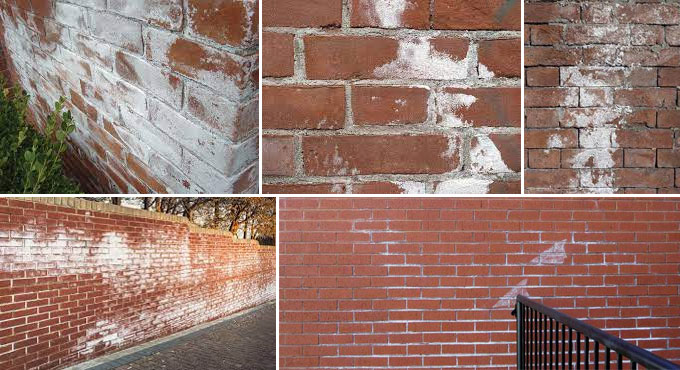
Efflorescence in Brickwork: A Comprehensive Exploration of Understanding and Control

Brick, with its timeless aesthetic and durability, has been a staple in construction for centuries. However, even this venerable building material is not immune to the challenges presented by efflorescence. Efflorescence, a phenomenon often misunderstood, can mar the appearance and compromise the structural integrity of brickwork.
What is Efflorescence?
A. Definition and Origins:
Efflorescence is a crystalline deposit that appears on the surface of brickwork, typically as a white, powdery substance. While it can affect various construction materials, including concrete and stone, its presence on brick surfaces is a common concern. Efflorescence results from the migration of soluble salts through porous materials, reacting with carbon dioxide and moisture to form visible crystals on the surface.
B. Common Salts Involved:
The salts responsible for efflorescence commonly include calcium sulfate, calcium carbonate, and various sulfates and chlorides. These salts are present in the building materials themselves, the surrounding soil, or can be introduced during the construction process.
Causes of Efflorescence in Brickwork
A. Water Infiltration:
One of the primary culprits behind efflorescence is water infiltration. When water penetrates the porous structure of bricks, it dissolves soluble salts along its path. As the water migrates to the surface and evaporates, it leaves the salts behind, leading to the formation of efflorescence.
B. Poor Quality Bricks:
The quality of the bricks used in construction plays a significant role in efflorescence. Bricks with high levels of water-soluble salts are more prone to efflorescence, emphasizing the importance of using high-quality, well-fired bricks in construction projects.
C. Mortar Composition:
The composition of mortar used in bricklaying can contribute to efflorescence. Mortars containing excessive soluble salts or those with inadequate curing time may introduce salts to the brickwork, exacerbating the issue.
D. Climatic Conditions:
Weather conditions, particularly in regions with high humidity or frequent cycles of wetting and drying, can influence the occurrence of efflorescence. The fluctuation of moisture levels in the brickwork due to weather patterns can accelerate the migration of salts to the surface.
Identifying Efflorescence
A. Visual Appearance:
Efflorescence is visually distinctive, presenting as a white, powdery deposit on the surface of brickwork. While the appearance is unmistakable, it is crucial to differentiate efflorescence from other potential causes of discoloration, such as mold or mineral deposits.
B. Location Patterns:
Efflorescence tends to appear in specific patterns on the brick surface. It commonly emerges along mortar joints and can form a map-like pattern, following the flow of water through the brickwork. Understanding these patterns can provide insights into the source of water infiltration.
C. Seasonal Variation:
Observing the seasonal variation of efflorescence can be informative. Efflorescence may be more pronounced during periods of increased humidity or rain, highlighting the correlation between moisture levels and salt migration.
Managing Efflorescence: Prevention and Remediation
A. Proper Construction Practices:
Prevention begins with proper construction practices. Using high-quality bricks with low water-soluble salt content and ensuring adequate mortar curing time are essential steps in minimizing the potential for efflorescence.
B. Moisture Management:
Addressing water infiltration is paramount in efflorescence management. Proper drainage systems, effective waterproofing, and attention to details like flashing can significantly reduce the likelihood of water reaching the brickwork.
C. Selection of Mortar:
Choosing the right type of mortar is crucial in preventing efflorescence. Mortars with low salt content and proper curing characteristics can minimize the introduction of salts into the brickwork.
D. Efflorescence Cleaners:
For existing efflorescence, various cleaners are available in the market. These cleaners are designed to dissolve and remove the efflorescence without causing damage to the bricks. However, it is essential to follow the manufacturer's guidelines and conduct a small test in an inconspicuous area before widespread application.
E. Sealing and Coating:
Applying a breathable sealer or coating to brick surfaces can help prevent water infiltration and minimize the migration of salts. It is crucial to choose a product specifically designed for brickwork, ensuring compatibility and long-term effectiveness.
F. Efflorescence-Resistant Bricks:
Advancements in brick manufacturing have led to the development of efflorescence-resistant bricks. These bricks are engineered to have low water-soluble salt content, reducing the likelihood of efflorescence occurrence. While potentially more expensive, the long-term benefits in terms of appearance and maintenance may justify the investment.
Future Considerations and Best Practices
A. Holistic Approach to Design:
Efflorescence management should be part of a holistic approach to building design and construction. Architects, engineers, and contractors should collaborate to incorporate effective moisture management strategies into the overall design, preventing efflorescence from becoming a recurring issue.
B. Regular Maintenance:
Periodic inspection and maintenance of brickwork are crucial for identifying and addressing efflorescence promptly. Early intervention can prevent the issue from escalating and causing further damage.
C. Educating Stakeholders:
Educating all stakeholders, including builders, contractors, and homeowners, about efflorescence and its causes is essential. Increased awareness can lead to proactive measures during construction and a more informed response to efflorescence when it occurs.
To learn more, watch the following video tutorial.
Video Source: Tidal Washers
D. Continued Research and Development:
As construction materials and techniques evolve, ongoing research and development efforts should focus on creating materials and methods that are inherently resistant to efflorescence. This may involve advancements in brick manufacturing, mortar composition, and sealant technologies.
Conclusion
Efflorescence in brickwork, though a common challenge, is not insurmountable. With a thorough understanding of its causes and effective management strategies, the construction industry can mitigate the impact of efflorescence and preserve the aesthetic and structural integrity of brick structures.
As construction practices continue to evolve, a proactive approach to efflorescence management should be integral to the design, construction, and maintenance processes. By adopting best practices, leveraging advancements in materials, and staying informed about emerging solutions, the construction industry can minimize the occurrence of efflorescence and ensure the longevity and beauty of brickwork in the built environment.


